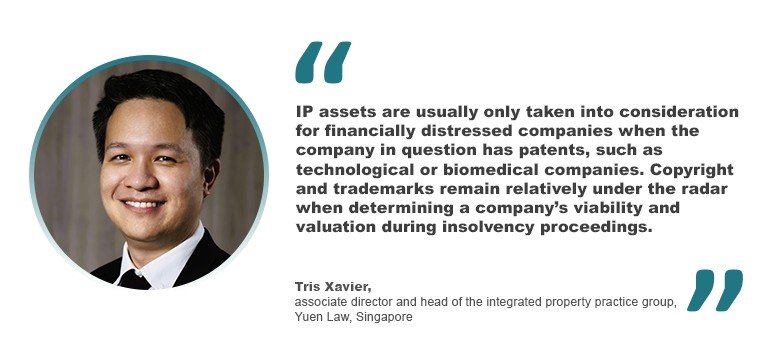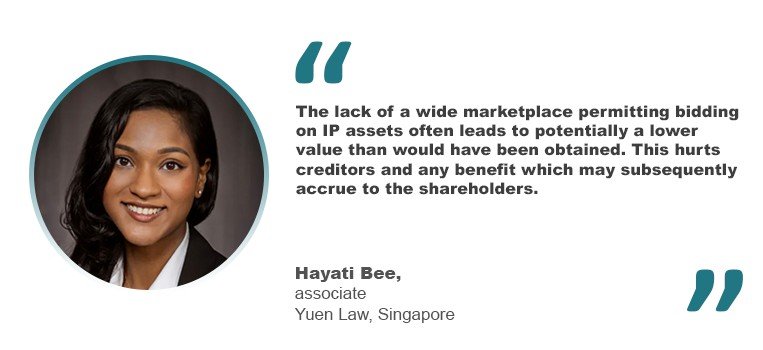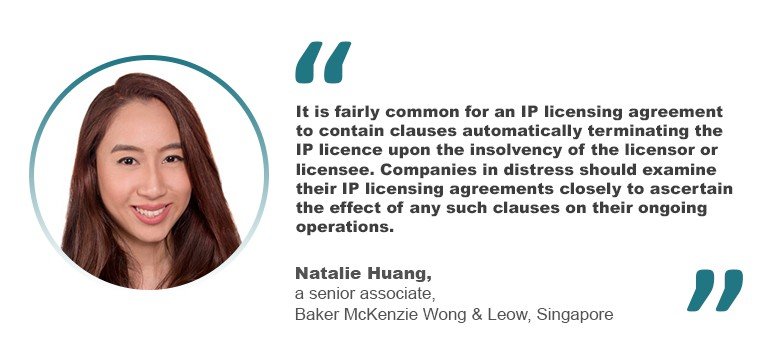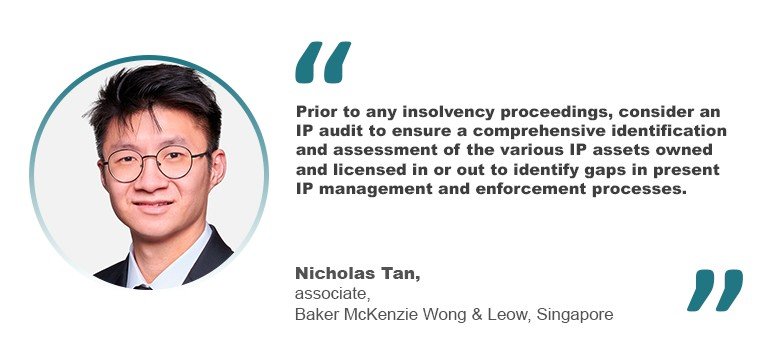Navigating IP in insolvency
31 May 2025

In insolvency, proper valuation and management of IP are crucial for preserving company value during financial distress. Excel V. Dyquiangco discusses the importance of adhering to legal compliance to prevent the risk of undervaluation and ensure that IP assets are accurately represented and maximized.
Intellectual property has become a cornerstone of modern businesses, representing a significant portion of their value. Yet, when a company faces financial distress and insolvency, the fate of its IP assets becomes a complex issue with far-reaching implications.
Unlike tangible assets, IP is intangible and often difficult to value. In insolvency proceedings, these assets become crucial for maximizing returns for creditors and preserving the company’s value for potential restructuring or sale.

“In our experience, IP assets are usually only taken into consideration for financially distressed companies when the company in question has patents, [such as] technological or biomedical companies,” explained Tris Xavier, an associate director and head of the integrated property practice group at Yuen Law in Singapore. “Copyright and trademarks remain relatively under the radar when determining a company’s viability and valuation during insolvency proceedings. However, it appears to be an area for growth as more companies are seeking to monetize their non-patent IP assets. Accurate valuation is a big issue, with valuation of intangible rights, such as IP, being relatively nascent, and with a higher likelihood of leading to greater variance in outcomes compared to other types of property.”
He continued: “Subsisting licences over a company’s IP (irrespective of what type of IP is being licenced) may be immensely valuable as they continue to generate revenue for the company despite the ongoing insolvency proceedings. Depending on the quantum of the licence fees and the remaining term of the licence, this may have a marked impact on the company’s valuation during insolvency proceedings.”
“While noting that ordinarily, most license agreements will likely provide for an event of default when the company enters insolvency or restructuring proceedings, it is worth flagging Section 440 of the Insolvency Restructuring and Dissolution Act 2018. The section provides that unless specifically exempted, no right or obligation with a company can simply be terminated by virtue of the company entering proceedings under the Act. This should allow companies to continue exploiting their IP and to benefit from any licenses it may have given or granted,” he said.
With the transfer or retention of IP assets impacting the ongoing operations of a company undergoing insolvency, the directors have completed their duties and no longer run the business. The liquidator will be seeking to realize the assets for the best possible value for the creditors’ benefit.
“In judicial management or a scheme of arrangement, as with any other asset, the transfer can have a marked impact on the continued viability of the company, particularly where the company is heavily dependent on the economic benefit of the IP in question. However, this is a delicate balancing act between the continued viability of the company and the need for funds to turn the company around,” said Xavier.
His colleague, Hayati Bee, an associate at the same firm, noted that one common legal challenge generally faced by smaller companies in insolvency is the transfer of assets when the company begins to sink under the weight of insolvency. “Legally speaking, such transfers are prone to be unwound as unfair preferences (i.e. to related parties or to benefit one creditor over another) or undervalue transactions (being transferred below its actual value),” she said. “The latter is likely more commonplace given the relative youth of the IP valuation industry in Singapore, as alluded to earlier.”

She added: “Another issue is the lack of a wide marketplace permitting bidding on IP assets, often leading to potentially a lower value than would have been obtained. This hurts creditors and any benefit which may subsequently accrue to the shareholders. In our experience, we have observed situations where the only buyer is the existing management, who may be more clued into the actual value of the IP.”
A lifeline in insolvency
According to Emmanuel Chua, a principal in the dispute resolution practice group of Baker McKenzie Wong & Leow in Singapore, IP assets in principle can add to a company’s overall valuation and generate new revenue streams. This would be helpful in insolvency proceedings, especially for technology-driven or innovative enterprises. He said that proper valuation and utilization of these assets could potentially increase the total value of a company’s assets available for creditors.

“For example, companies with robust IP portfolios may be more attractive to potential investors or buyers during insolvency proceedings,” he said. “Dormant IP assets could generate new revenue streams through licensing or sale. IP assets can also be used as collateral for financing, which would be especially important for companies in distress. However, effective use of such IP assets depends on a number of factors such as proper IP portfolio management, accurate valuation and the ability to monetize such assets – especially in times of literal distress. Specifically in relation to the last point, tangible assets such as real estate, equipment or inventories have a more widely accepted liquidation process compared to intangible assets (IA) or IP. This is further complicated by the fact that illiquid IA or IP assets may face fluctuations in value and uncertainty of disposal in distressed situations.”
He continued: “That said, Singapore is working on developing a credible and trusted IP valuation ecosystem to enable companies to unlock the value of IA or IP, including putting in place relevant IP valuation practice standards and guidelines, which would go some way towards alleviating the problems described above.”
Chua also highlighted the importance of identifying what IP is owned and what IP is licensed by the insolvent company and determining the existence of any third-party rights over IP assets before any transfer process in insolvency proceedings.
“Licence agreements should be reviewed to assess whether such licences will continue in force after insolvency and whether such IP rights may be transferred,” he explained. “Generally, a licence agreement remains valid during an insolvency proceeding, subject to contractual provisions (such as those stipulating insolvency as an event of termination) and subject to the licence agreement being disclaimed by the judicial manager or liquidator or discharged by the court.”
He added this licence agreement may also provide for automatic termination upon the insolvency of either party. While contractual provisions automatically terminating licences upon the insolvency of the licensor or licensee are fairly common and generally enforceable, under the Singapore Insolvency, Restructuring and Dissolution Act (IRDA), contractual provisions automatically terminating licences after the commencement of judicial management or scheme of arrangement proceedings may be void and unenforceable if such termination is by reason only that those proceedings are commenced or that the company is insolvent.
“Further, contractual provisions automatically transferring licensed IP rights to a licensee in the event of the licensor’s insolvency may be deemed as a transaction at an undervalue pursuant to the IRDA, subject to whether the licensee provided consideration for acquiring the IPR and the relevant statutory conditions, such as whether the licensor entered the transaction in good faith and for the purpose of carrying on its business. Such provisions may potentially also be void for contravening public policy pursuant to the common law anti-deprivation rule, subject also to whether the licensor entered the transaction in good faith or for the predominant purpose of depriving its property on insolvency,” he said.
He added: “It should also be considered whether any intended transfer of IP would result in any breaches or infringement of existing agreements concerning such IP. Obtaining a proper valuation of the IP assets prior to any transfer is also important to ensure that such transfer will not be considered at an undervalue. A transfer of IP assets may fall foul of anti-avoidance provisions if it is deemed as a transaction at an undervalue or an unfair preference pursuant to the IRDA.”
Managing IP transfers
With the transfer or retention of IP assets significantly impacting the ongoing operations of a company in distress in Singapore, Natalie Huang, a senior associate at Baker McKenzie Wong & Leow in Singapore, said that it is fairly common for an IP licensing agreement to contain clauses automatically terminating the IP licence upon the insolvency of the licensor or licensee.

“Companies in distress should therefore examine their IP licensing agreements closely to ascertain the effect of any such clauses on their ongoing operations,” she said. “For example, if the company in distress is an IP licensor, the termination of such IP licences could decrease the revenue flowing in from such licences, which would exacerbate the company’s poor financial standing even further. If the insolvent company is a licensee, it should ensure that it continues to have the right to use critical licensed IP assets as may be required to conduct its business. Termination of any critical IP licensing arrangements would disrupt the ongoing operations of the insolvent company. Companies in distress should also ensure that any transfer of IP assets is permitted under the terms of the relevant contractual obligations they owe to other parties.”
She added: “They should also be mindful that the transfer of IP rights leading up to insolvency proceedings may fall afoul of anti-avoidance provisions if deemed to be a transaction at an undervalue or an unfair preference transaction.”
In sharing best practices for compliant and successful management of IP assets during insolvency proceedings, particularly with maintaining the value and integrity of these assets, her colleague Nicholas Tan, an associate in the dispute resolution practice group at the same firm, emphasized the need for a case-by-case basis, taking into consideration available resources. He offered the following suggestions:

-
Being prepared is key. “Prior to any insolvency proceedings, consider an IP audit to ensure a comprehensive identification and assessment of the various IP assets owned and licensed in or out – to identify gaps in present IP management and enforcement processes and to put in place standard operating procedures and policies to plug such gaps,” he said. “Implement and maintain robust IP portfolio management policies and practices to safeguard the company’s IP.”
-
Review documents relevant to key IP assets to understand the various rights, restrictions and obligations at play, particularly any provisions triggered on insolvency.
-
Negotiate with creditors to find mutually beneficial solutions, including solutions that preserve the value of the IP assets.
-
Identify which IP assets are core to the business and which could be sold or licensed. Explore the possibility of entering strategic partnerships or joint ventures to continue developing and profiting from the IP assets and/or consider suitable restructuring strategies and options.
-
Obtain an independent professional valuation to ensure IP assets are correctly valued before any transfer.
-
Any sale or transfer of IP assets should be shown to be in good faith and documented. This should include a careful consideration of the merits, motives and relevant approvals (if required) in respect of the proposed transaction.
He added: “Seek professional advice relating to IP and insolvency to navigate the complex legal landscape and negotiations and ensure compliance.”






